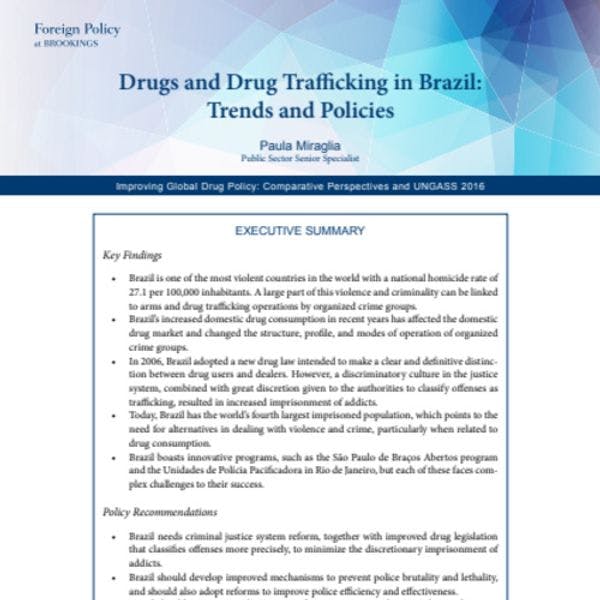Drogas y tráfico de sustancias en Brasil: Tendencias y políticas
Este informe analiza los modelos operativos de las bandas criminales organizadas en Brasil, los cambios en el mercado de la droga y los patrones de consumo en el país, y cómo se establece el ciclo que alimenta la violencia en tensión con la nueva legislación y las respuestas de políticas. Más información, en inglés, está disponible abajo.
Urban violence and crime have been rising in Brazil for the past four decades, despite progressive improvement in the country’s social and economic conditions. Violence is usually recognized as a multi-causal phenomenon in Brazil, linked to a broader social and economic context. Violence should also be understood as a result of the activities of organized crime groups who run illegal drugs and firearms markets, combined with weak institutions and poor policy responses.
This paper examines the operational models of Brazilian organized crime groups, the changes in drug market and consumption patterns in the country, and how a cycle that feeds violence is established in tension with new legislation and policy responses. By analyzing initiatives such as a program to reduce crack use in São Paulo (São Paulo de Braços Abertos) and the Police Pacification Units (Unidades de Polí- cia Pacificadora, UPPs) in Rio de Janeiro, the paper points to the limits of the current conceptualization of safety and security in Brazil and indicates how an understanding of these limits should be used to shape new policy responses.
Key Findings
- Brazil is one of the most violent countries in the world with a national homicide rate of 27.1 per 100,000 inhabitants. A large part of this violence and criminality can be linked to arms and drug trafficking operations by organized crime groups.
- Brazil’s increased domestic drug consumption in recent years has affected the domestic drug market and changed the structure, profile, and modes of operation of organized crime groups.
- In 2006, Brazil adopted a new drug law intended to make a clear and definitive distinction between drug users and dealers. However, a discriminatory culture in the justice system, combined with great discretion given to the authorities to classify offenses as trafficking, resulted in increased imprisonment of addicts.
- Today, Brazil has the world’s fourth largest imprisoned population, which points to the need for alternatives in dealing with violence and crime, particularly when related to drug consumption.
- Brazil boasts innovative programs, such as the São Paulo de Braços Abertos program and the Unidades de Polícia Pacificadora in Rio de Janeiro, but each of these faces complex challenges to their success.
Policy Recommendations
- Brazil needs criminal justice system reform, together with improved drug legislation that classifies offenses more precisely, to minimize the discretionary imprisonment of addicts.
- Brazil should develop improved mechanisms to prevent police brutality and lethality, and should also adopt reforms to improve police efficiency and effectiveness.
- Brazil should mainstream the concept of prevention in its domestic drug policy programs.
Keep up-to-date with drug policy developments by subscribing to the IDPC Monthly Alert.
Descargas
Temas
Regiones
Perfiles relacionados
- Brookings Institution
